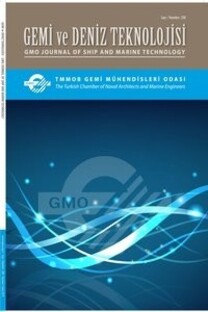Kompozit Bir Teknenin Dip Levhasının Sonlu Elemanlar Yöntemi ile Analizi ve Yapısal Optimizasyonu
kompozit tekne, destekli plaka, oryantasyon optimizasyonu, katman kalınlığı optimizasyonu
Analysis and Structural Optimization of the Bottom Plate of a Composite Boat with Finite Element Method
___
- Chen, N.-Z., & Guedes Soares, C. (2007). Longitudinal strength analysis of ship hulls of composite materials under sagging moments. Composite Structures, 77(1), 36-44.
- Chen, N.-Z., & Soares, C. G. (2008). Ultimate Longitudinal Strength of Ship Hulls of Composite Materials. Journal of Ship Research, 52(03), 184-193.
- Colombo, C., & Vergani, L. (2014). Influence of delamination on fatigue properties of a fibreglass composite. Composite Structures, 107, 325-333.
- ISO. (2018). ISO 12215-5:2018—Small craft—Hull construction and scantlings—Part 5: Design pressures for monohulls, design stresses, scantlings determination.
- Imran, M., Shi, D., Tong, L., & Waqas, H. (2019). Design optimization of composite submerged cylindrical pressure hull using genetic algorithm and finite element analysis. Ocean Engineering, 190, 106443.
- Kai, Q., Renjun, Y., Wei, S., & Yaoyu, H. (2020). Research on the tension damage behavior of sandwich composite L-joints: Experiment and simulation. Composite Structures, 232, 111566.
- Kharghani, N., Alizadeh, F., Soares, C. G., & Tsouvalis, N. G. (2019). Experimental and numerical study of a composite-to-steel joint under bending and torsion loads. Proceedings of the Institution of Mechanical Engineers, Part M: Journal of Engineering for the Maritime Environment, 233(3), 722-734.
- Kharghani, N., & Guedes Soares, C. (2018). Experimental, numerical and analytical study of bending of rectangular composite laminates. European Journal of Mechanics - A/Solids, 72, 155-174.
- Khosravani, M. R., & Weinberg, K. (2017). Experimental investigations of the environmental effects on stability and integrity of composite sandwich T-joints. Materialwissenschaft Und Werkstofftechnik, 48(8), 753-759.
- Khosravani, M. R., & Weinberg, K. (2018). Characterization of sandwich composite T-joints under different ageing conditions. Composite Structures, 197, 80-88.
- Kolanu, N. R., Raju, G., & Ramji, M. (2018). Experimental and numerical studies on the buckling and post-buckling behavior of single blade-stiffened CFRP panels. Composite Structures, 196, 135-154.
- Kutupoğlu, V., Akpınar, A., Bingölbali, B., & Çakmak, R. E. (2018). Marmara Denizi Üzerinde Maksimum Belirgin Dalga Yüksekliklerinin Alansal Dağılımları. İmo 9. Kıyı Mühendisliği Sempozyumu Kasım 1, 2018.
- Li, B., Gong, Y., Gao, Y., Hou, M., & Li, L. (2022). Failure Analysis of Hat-Stringer-Stiffened Aircraft Composite Panels under Four-Point Bending Loading. Materials, 15(7), Article 7.
- Li, H., Yao, Y., Guo, L., Zhang, Q., & Wang, B. (2018). The effects of delamination deficiencies on compressive mechanical properties of reinforced composite skin structures. Composites Part B: Engineering, 155, 138-147.
- Li, X., & Zhu, Z. (2020). Optimization Design of a Composite Hull Stiffened Panel Considering Structural Stability.
- Mantari, J. L., & Guedes Soares, C. (2013). Finite element formulation of a generalized higher order shear deformation theory for advanced composite plates. Composite Structures, 96, 545-553.
- Ma, L., & Liu, D. (2016). Delamination and fiber-bridging damage analysis of angle-ply laminates subjected to transverse loading. Journal of Composite Materials, 50(22), 3063-3075.
- Mo, Y., Ge, D., & He, B. (2016). Experiment and optimization of the hat-stringer-stiffened composite panels under axial compression. Composites Part B: Engineering, 84, 285-293.
- Morshedsolouk, F., & Karimirad, M. (2021). Postbuckling of Marine Stiffened Composite Plates with Initial Geometric Imperfections Using Progressive Failure Analysis. Journal of Marine Science and Application, 20(4), 694-705.
- Mouring, S. E. (1999). Buckling and postbuckling of composite ship panels stiffened with preform frames. Ocean Engineering, 26(8), 793-803.
- Raju, Prusty, B. G., & Kelly, D. W. (2013). Delamination failure of composite top-hat stiffeners using finite element analysis. Proceedings of the Institution of Mechanical Engineers, Part M: Journal of Engineering for the Maritime Environment, 227(1), 61-80.
- Saraçoğlu, K. E., Yüksel, Y., Aydoğan, B., & Aydoğan, B. (2014). Marmara Denizi Dalga Enerji Potansiyelinin Belirlenmesi. 8. Kıyı Mühendisliği Sempozyumu Kasım 8, 2014.
- Schilling, J. C., & Mittelstedt, C. (2022). Local postbuckling of omega-stringer-stiffened composite panels. Thin-Walled Structures, 181, 110027.
- SudhirSastry, Y. B., Budarapu, P. R., Madhavi, N., & Krishna, Y. (2015). Buckling analysis of thin wall stiffened composite panels. Computational Materials Science, 96, 459-471.
- Zhang, X., Dai, W., Cai, B., Li, C., Huang, W., & Fang, C. (2022). Numerical and Experimental Investigation of Bearing Capacity for Compressed Stiffened Composite Panel with Different Stringer Section Geometries. Applied Composite Materials, 29(4), 1507-1535.
- Zhao, W., Xie, Z., Wang, X., Li, X., & Hao, J. (2019). Buckling behavior of stiffened composite panels with variable thickness skin under compression. Mechanics of Advanced Materials and Structures, 26(3), 215-223.
- ISSN: 1300-1973
- Yayın Aralığı: 2
- Başlangıç: 1955
- Yayıncı: TMMOB Gemi Mühendisleri Odası
Tersanelerde Vinç ile Yük Elleçleme Operasyonları ve FRAM Yöntemi Kullanılarak Risk Analizi
Selahattin ÖZSAYAN, Barış BARLAS
Düzeltme: Tersanelerde Yüksekte Çalışma Risklerinin AHP Tabanlı PROMETHEE ile Analiz Edilmesi
Murat YORULMAZ, Mehmet Arif ÖZTÜRK
Denizaltı Gövdesinden Türetilen Bir Formun Boyutsuz Hidrodinamik Katsayılarının Belirlenmesi
Baş-Kıç Vurma ve Dalıp-Çıkma Hareketinin HAD Yöntemi Kullanılarak İncelenmesi
Yavuz Hakan OZDEMİR, Taner ÇOŞGUN
Kompozit Bir Teknenin Dip Levhasının Sonlu Elemanlar Yöntemi ile Analizi ve Yapısal Optimizasyonu
Recep Tayyip KILIÇ, M. Erden YILDIZDAG
